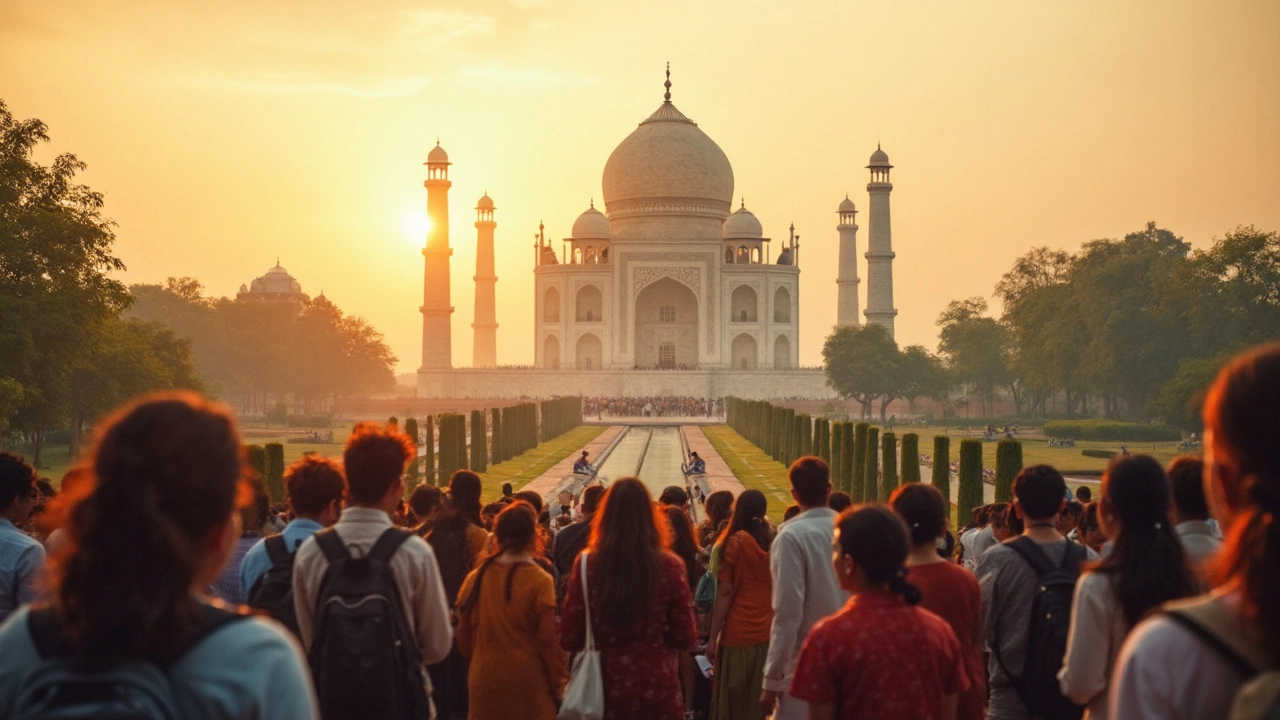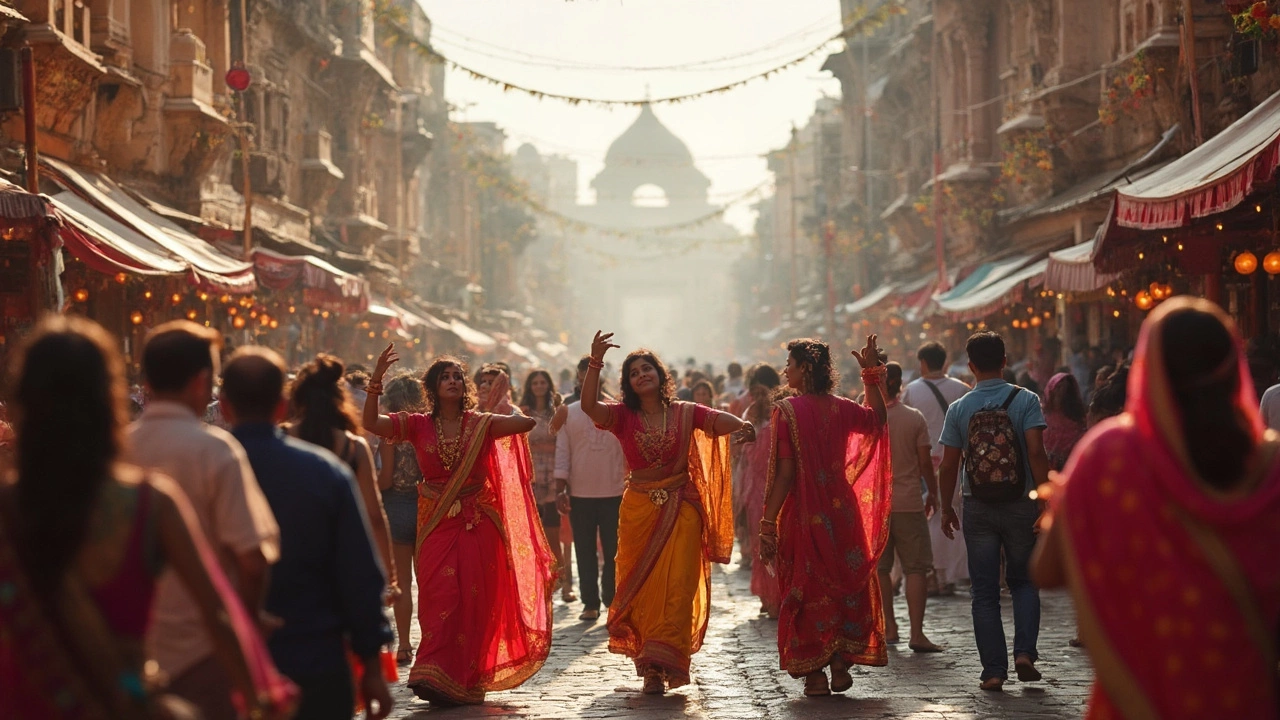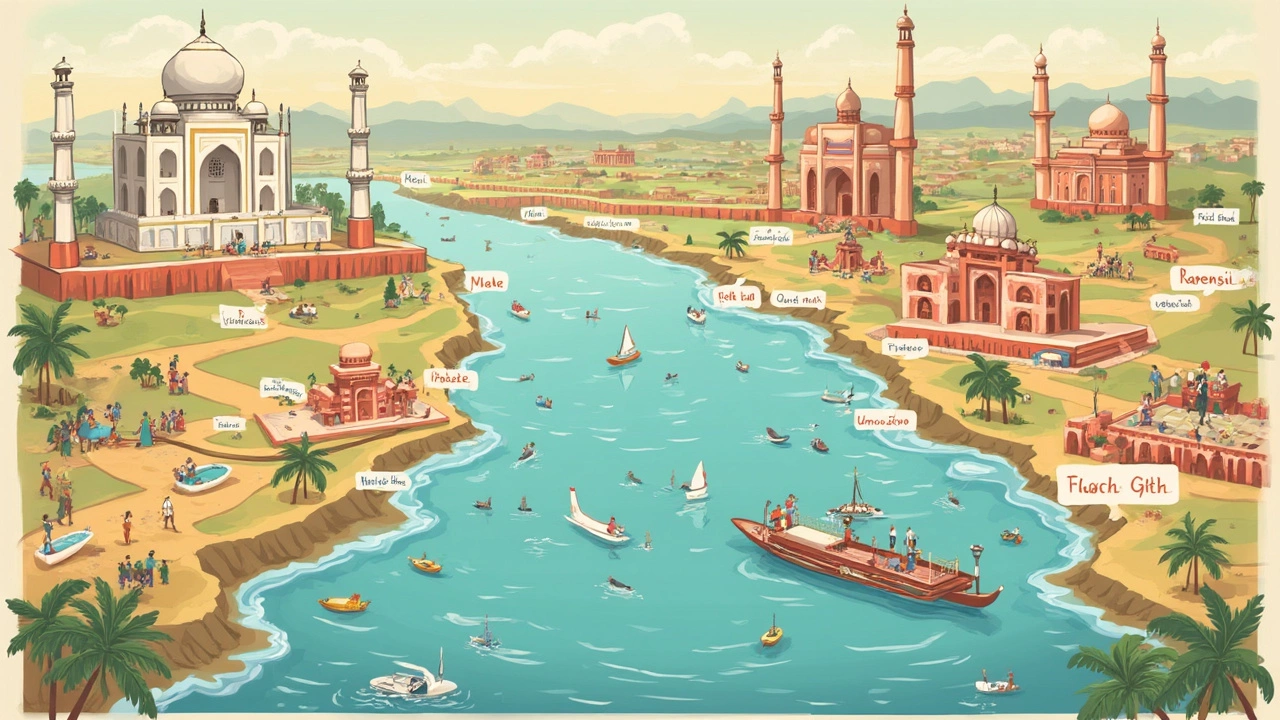India's Rank in Tourism: How Cultural Wonders Stack Up
 May, 25 2025
May, 25 2025
India is like that friend who never lets your stories get boring—there’s always another twist, another wonder. When it comes to tourism, people across the globe can’t seem to get enough. According to the latest UNWTO report for 2024, India sits at number 22 in international tourist arrivals. That might not sound crazy high, but when you look at cultural tourism, India jumps way up the pecking order—thanks to its whopping 42 UNESCO World Heritage Sites and festivals that spill into every calendar month.
Planning to explore ancient forts, dance at a Rajasthani fair, or get lost in Varanasi’s ghats? Knowing where India stands in the world of travel isn’t just trivia—it helps you spot what’s really special (and what crowds you might have to dodge in peak season). Plus, a lot of the buzz isn’t just about the Taj Mahal; there’s a reason why cities like Khajuraho, Hampi, and Jaipur keep showing up in top ten lists for culture lovers. Get ready to see how India’s heritage and energy set it apart from the usual tourist hotspots.
- Where India Stands in Global Tourism Rankings
- What Makes India a Top Cultural Tourism Spot
- Key Heritage Sites That Attract Visitors
- Challenges India Faces in Tourism
- Tips for Traveling Through India’s Cultural Hubs
Where India Stands in Global Tourism Rankings
When we talk straight numbers, India isn’t in the world’s tourism top ten, but there’s more to the story. According to the UN World Tourism Organization, India was ranked 22nd for international tourist arrivals in 2024, pulling in around 17.9 million foreign visitors. Compare this with tourism giants like France, Spain, and the US, which each attract over 60 million visitors a year, and you see India could grow a lot more if some things change—better infrastructure, smoother visas, or more flight connections, for example.
But here's where it gets interesting. India climbs much higher for cultural tourism India. It’s consistently in the top ten for countries people want to visit for unique festivals, old cities, and traditions you can’t find anywhere else. Places like Agra, Jaipur, and Varanasi get flagged on every serious traveler's bucket list. Plus, India ranks 7th globally for the number of UNESCO World Heritage Sites, with 42 sites as of May 2025.
The mix of sights and experiences explains the unique tourism vibe in India. The tourism ministry’s own data shows over 1.7 billion domestic trips in 2023. That’s not a typo—Indians love to travel all over their own country. Domestic tourism is off the charts, which means the infrastructure tends to be built for big crowds, even if a lot of those are locals.
Here’s a snapshot of how India stacks up against a few other major countries on international arrivals in 2024:
| Country | Tourist Arrivals (Millions) | Ranking |
|---|---|---|
| France | 79.4 | 1 |
| Spain | 75.6 | 2 |
| USA | 74.2 | 3 |
| Thailand | 30.8 | 8 |
| Turkey | 29.9 | 9 |
| India | 17.9 | 22 |
So, if you’re looking at pure international arrivals, there’s room for India to step up. But if your goal is rich experiences, wild festivals, and mind-blowing history? Nobody does it like India.
What Makes India a Top Cultural Tourism Spot
It’s not just about big monuments or famous photographs—what really keeps travelers hooked on India is its mix of history, living traditions, and festivals that light up whole cities. The country packs more than 4,000 years of culture and it shows: temples, palaces, bazaars, and rituals fill every corner, and every region feels like a totally new story.
According to India’s Ministry of Tourism stats for 2024, over 17 million travelers visited for cultural reasons alone, and about 72% of foreign tourists list culture as their top pull. Whether you’re a first-timer or coming back for your tenth visit, it’s the vibe of old and new that makes India a magnet for cultural explorers.
- There are 42 UNESCO World Heritage Sites here—ranging from ancient Ajanta Caves in Maharashtra to the epic temples of Mahabalipuram in Tamil Nadu.
- Major festivals like Holi, Diwali, and Pushkar Camel Fair pull not just locals but travelers from around the world who want to join in.
- Every region brings something unique: Kerala’s traditional Kathakali dance isn’t found in Delhi, and you won’t catch a Ladakhi monastery festival in Rajasthan.
To help you see just how packed India is with cultural stuff, check this quick breakdown:
| Feature | India | Global Comparison |
|---|---|---|
| UNESCO World Heritage Sites | 42 | 6th highest in the world |
| Annual Cultural Tourists (2024) | 17 million | Ranks in global top 10 |
| Major Festivals Celebrated | Over 50,000 | Most globally for a single country |
If you’re looking for a real deep dive into India tourism rank and why it matters, it’s clear: No other spot has this blend of ancient wonders and electric street life. You’ll find yourself snapping pics one minute and eating street food next to a temple that’s more than a thousand years old. That’s the kind of stuff India dishes out every single day.

Key Heritage Sites That Attract Visitors
If you ask travelers why they come to India, heritage spots are usually high on their list. It’s not just the India tourism rank that proves it—millions head straight to these jaw-dropping places every year.
The Taj Mahal gets all the hype, and for good reason. It’s one of the Seven Wonders of the World, pulling in around 7-8 million visitors a year. But that’s just the tip of the iceberg. Jaipur’s Amber Fort, the Qutub Minar in Delhi, and the sun-scorched ruins of Hampi attract huge crowds too. Each spot tells a different story, from Mughal glory to Chola temples that go back a thousand years.
Check out this quick rundown of some key Indian sites and their unique appeal:
- Taj Mahal, Agra: No surprise here—timeless, stunning, and a must-see.
- Qutub Minar, Delhi: The tallest brick minaret in the world. It's 239 feet of history you can’t ignore.
- Jaipur City, Rajasthan: The Pink City isn’t just pretty; it’s packed with palaces and the crazy Hawa Mahal.
- Hampi, Karnataka: Once a wealthy South Indian empire, now a giant open-air museum with boulder-studded landscapes.
- Khajuraho Temples, Madhya Pradesh: Famous for their detailed, candid stone carvings—PG-13, if you catch my drift.
- Konark Sun Temple, Odisha: Shaped like a massive stone chariot. Seriously, it’s wild.
- Mysore Palace, Karnataka: Opulent and decked out, especially during the Dasara festival.
- Red Fort, Delhi: Where Indian Independence Day speeches happen every year. Tons of history packed in red sandstone walls.
Here’s a look at visitor numbers for some of these spots (2023 figures):
| Site | Annual Visitors (Millions) |
|---|---|
| Taj Mahal | 7.1 |
| Qutub Minar | 3.8 |
| Amber Fort, Jaipur | 2.5 |
| Mysore Palace | 3.3 |
| Red Fort | 3.1 |
It’s smart to grab tickets online in advance, especially for the Taj Mahal, since entrance lines can get long and tickets sometimes sell out on packed days. Some places (like Khajuraho or Hampi) are more spread out, so rent a bike or auto-rickshaw for the day. Local guides can help you spot cool stuff—sometimes even stories you won’t find in your guidebook.
Challenges India Faces in Tourism
India’s tourism scene is full of color and excitement, but it’s not all smooth sailing. Anyone planning a trip or working in the industry will notice that some pretty big roadblocks keep coming up, year after year.
First up, there’s the issue of infrastructure. While major cities like Delhi and Mumbai boast flashy airports and hotels, rural areas and smaller cultural gems can feel worlds apart. Patchy roads, slow trains, and limited public transport sometimes make popular sites tougher to reach. This isn’t just an inconvenience; it knocks India down a few ranks in global tourism competitiveness reports.
Another pain point: cleanliness and sanitation. While efforts like the Swachh Bharat Mission (that’s the big national clean-up push) have made things better, reality on the ground can still be messy, especially near busy tourist spots. For many first-timers, the lack of clean restrooms and visible waste is a real shock.
Safety and security concerns also get talked about a lot. Petty theft, scams targeting foreigners, and occasional reports about harassment—especially of women travelers—do put off some tourists. India has introduced things like tourist police, helplines, and GPS tracking for taxis, but the bad headlines tend to stick.
- Crowd control is another headache, especially at cultural hot spots and festivals. Overcrowding at places like Taj Mahal or Kumbh Mela can be overwhelming, which impacts both the tourist experience and the heritage sites themselves.
- Getting a visa has become easier with the rise of e-visas, but bureaucratic processes and puzzling paperwork still frustrate a lot of people trying to visit.
Here’s a look at some recent stats, just to put things in perspective:
| Challenge | Recent Data (2023-24) |
|---|---|
| Poor infrastructure (rural) | Only 27% of heritage sites rated as "easily accessible" |
| Sanitation concerns | Survey: 44% of tourists said cleanliness was a major issue |
| Security incidents | Reported petty crime down 11%, but concerns remain high |
| Visa processing time | Average: 6 days (e-visa), 18 days (regular paper visa) |
| Overcrowding at popular sites | Taj Mahal averaged 30,000+ daily visitors in peak season |
It’s not all doom and gloom, though. Some cities and states are adapting fast, with better roads, new tourist police stations, and digital guides. If you plan ahead and stay clued in, you’ll still have an amazing time exploring India’s cultural tourism scene.

Tips for Traveling Through India’s Cultural Hubs
It’s easy to get overwhelmed by India’s size and nonstop energy, but you’ll save yourself a lot of headaches by planning ahead. Whether you’re aiming for world-famous sites or offbeat gems, these tips will help you make the most of your trip.
- India tourism rank is steadily rising thanks to better infrastructure—major airports in Delhi, Mumbai, and Bengaluru now have direct flights from dozens of international cities. Book flights well in advance for good deals.
- Stick to bottled water and eat freshly-cooked meals from busy, well-rated places, especially around crowded spots like Jaipur’s Amber Fort or Varanasi’s ghats. "Delhi belly" is real and can mess up your plans.
- Dress modestly, especially at religious sites like the Golden Temple or inside historic mosques. You’ll find scarves and inexpensive long pants at local markets if you forget.
- India’s train system is legendary—and can also be confusing. Use official apps like IRCTC Rail Connect for booking and check your platform info often. Overnight trains between cultural hubs like Agra and Khajuraho can save time and money.
- Most big cultural events, like Pushkar Camel Fair or Diwali in Varanasi, happen in fall and winter (October to March). This is when the weather is most pleasant and sightseeing is easiest.
- Bargaining is normal at markets, but don’t go overboard. A little friendly haggling gets you fair prices—locals expect it, especially in cultural destinations like Jaipur’s bazaars.
- Wi-Fi can be hit-or-miss, so grab a local SIM card at the airport for easy access to maps and translation apps. Geo-tag your favorite spots for later, and always download offline maps before hitting smaller towns.
Here’s a quick look at India’s top cultural hubs and average entry costs:
| City | Famous Site | Entry Fee (Foreigners) | Best Season |
|---|---|---|---|
| Agra | Taj Mahal | ₹1,100 | Oct-Mar |
| Jaipur | Amber Fort | ₹500 | Nov-Feb |
| Varanasi | Kashi Vishwanath Temple | Free | Oct-Mar |
| Hampi | Group of Monuments | ₹600 | Nov-Feb |
| Khajuraho | Western Group of Temples | ₹600 | Oct-Mar |
Transport between hubs is easier now, thanks to fast trains and frequent flights, but delays still happen. Always pad your itinerary with buffer time. Lastly, India loves festivals—ask hotel staff or locals about what’s happening nearby. Sometimes, the best experiences aren’t in any guidebook.